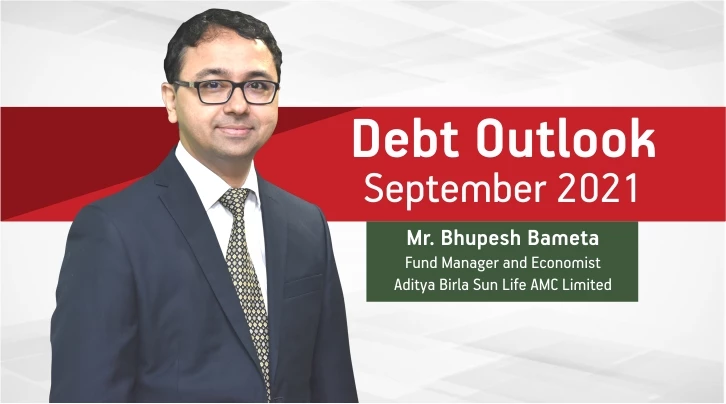-
Our Products
Our FundsFocus Funds
-
Self Care
Self-ServiceFind InformationWays To TransactPartner Solutions
-
Downloads
- Learnings
- About Us
-
More
-
Shareholders
-
Shareholders
-
Updates
-
-
SIP Calculators
- Back
-
Shareholders
Debt Outlook - September 2021

Sep 23, 2021
5 min
5 Rating
 Bhupesh Bameta
Bhupesh Bameta
Global macro and market:Variety of global high frequency indicators are suggesting that we are past the peak of post-Covid rebound, and there is moderation in global growth momentum. Global Purchasing Managers’ Indices have moderated sharply, global trade has plateaued, US GDP, employment, retail sales and survey indicators have rolled over, and Chinese and East Asian growth numbers have disappointed. Moreover, data surprise indices have also plummeted.
Key reasons for the slowdown are:
1) Natural slowdown after stellar growth numbers in past few quarters, particularly with very strong consumption demand in goods,
2) big spread in Delta variant has hit consumer confidence and the particularly effected services sector which was expected to take the gauntlet from goods sectors,
3) fiscal stimulus and its impact on growth is gradually waning,
4) continued supply-side bottlenecks, although easing, has remained elevated pulling down output and fuelling inflationary pressures.
The key near term worry for global economy and markets stems from still elevated inflation and sharp rise in delta variant. There are early indications that vaccines have lower eflcacy against delta variant and the possible decline in effectiveness of vaccines with time. Besides the immediate impact on growth numbers, it also raises concerns on evolution of growth trajectory. Since if the vaccines’ eflcacy is not full-proof and wanes with time then the pandemic will likely be a long-drawn affair, even if its economic impact may dampen.
Timing for Taper remains the key monitorable for the asset markets. For most of August message from Fed speakers, including Chair Powel suggested Taper to begin towards end 2021, but the disappointing August US jobs data has created doubts on timelines with most of the market expecting Taper to begin in early 2022. Global equities market remains strong, with Developed Markets equities repeatedly making new highs, while Emerging Markets equities have continued to stay under pressure, reflecting pressure on growth, strong Delta wave, low vaccination, and low policy support. Global yields have remained low tracking US yields. Commodities prices remain elevated, even if the price-rise has stalled. U.S. Dollar Index has been on weakening mode after rising to 93.57 in mid-Aug.
India macro: Headline Gross Value Added for June quarter came optically at "record" high, due to record low base in same quarter last year. Adjusting for base and taking 2yr Compound Annual Growth Rate growth suggest a much sober picture with 2yr CAGR growth at -4%. However, economy has been recovering swiftly in second quarter and cumulative activity indicators are already above pre-second wave levels, with most of indicators showing decent rebound. Overall, the impact of second wave on economy has been much lower than the first wave. However, consumer confidence has been badly hit which will weigh on recovery going ahead.
Covid infections numbers have remained at about 90% lower from peak levels but there are pockets of concern, with cases remaining high in Kerala and some pickup of cases in Mumbai. The upcoming festival season, together with new data emerging on gradual decline in vaccine immunity with time means that Covid worries will stay for some more time at the least and worries about third wave are not over. On the positive side, vaccination is progressing well averaging about 80 lakh dose per day in the last 7 days and total vaccine dosages have crossed 66cr. Also, it may be noted that seroprevalence in India is quite high with significant population has already got infected in the second wave most likely against delta variant and have some sort of natural immunity.
Macro stability indicators: India inflation moderated for the second consecutive month in July, coming down to 5.59% aided by higher base and moderate m-m momentum. We expect more moderation in inflationary momentum in coming months and continue to expect inflation to average 5.5-5.75% in FY22. Fiscal account for FY22 remains quite healthy compared to budgeted numbers due primarily to robust tax collections and somewhat muted expenditure growth. There is good possibility that FY22 fiscal deficit will eventually end up closer to 6% compared to budgeted 6.8%. External sector continues to do good with exports rising by 12.9% (2year CAGR) in August owing to strong global demand. Trade deficit has remained benign, although inching up.
Indian yields have softened across the spectrum in last 30 days with inflation turning out to be lower than market fears, robust tax collections, muted credit growth, abundant liquidity creating pressure to deploy, and benign US yields. Government bond auctions have also witnessed robust demand.
Source: Bloomberg, CEIC, RBI
Mutual Fund investments are subject to market risks, read all scheme related documents carefully.
Market Outlook: RBI continues to stay dovish and support markets. The message emanating from RBI has been that the current spike in Consumer Price Index is largely driven by supply-side factors, which will moderate in coming quarters. In addition, they feel that the process of economic revival is very delicately poised, and it is important to nurture and revive the process of growth and any hasty reversal of monetary policy will undermine the nascent recovery.
We believe that the course of monetary policy will be determined primarily by evolution of growth, unless inflation surprises very negatively, and monetary policy will be growth supportive till RBI gains more confidence on the sustainability of recovery. However, excessive liquidity is becoming a challenge for RBI with banking system liquidity rising to INR10 tn levels, and prospect of more liquidity injection as RBI confronts with the challenge of supporting government borrowing programme and keeping currency competitive. We foresee more steps by RBI to withdraw liquidity in the upcoming months, which may create bouts of volatility that the markets will have to contend with, even as we expect policy normalisation to be more gradual than what the markets are pricing.
Fixed income investors can benefit from steep curves, and there is compensation/insurance available for investors who can stay patiently invested in funds matching their investment horizon with respective scheme duration to benefit from the steepness in curve. Roll-down strategy which we are running in Floater, PSU, Banking and Gilt fund, remains an attractive strategy given the steepness of yield curve till 5-6 years. With ‘accrual returns’ in focus, investors can also look at allocating a part of their corpus Aditya Birla Sun Life Credit Risk Fund where we are running a duration of 1.5 – 2 years. We also expect stronger corporate balance sheets and earnings to lead to a rating upgrade cycle resulting in spread reduction in credit papers





 1800-270-7000
1800-270-7000



